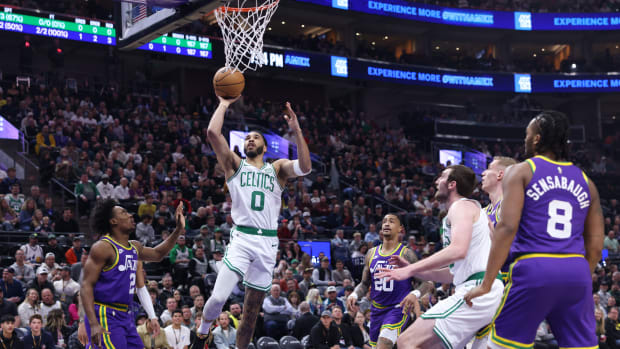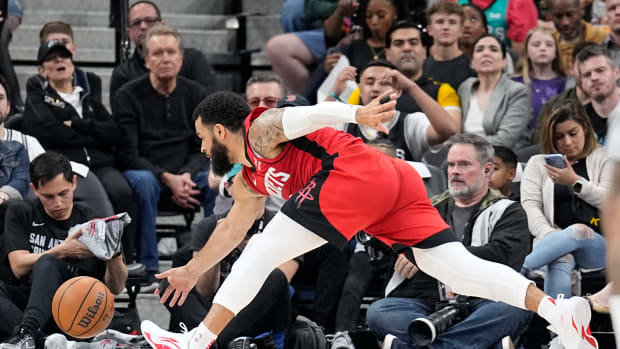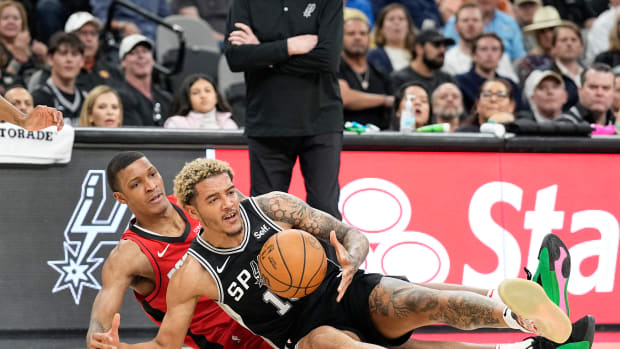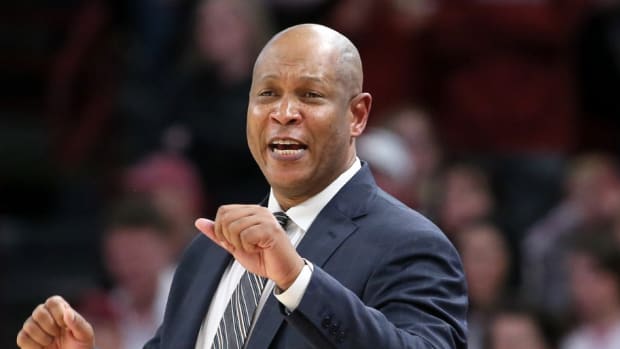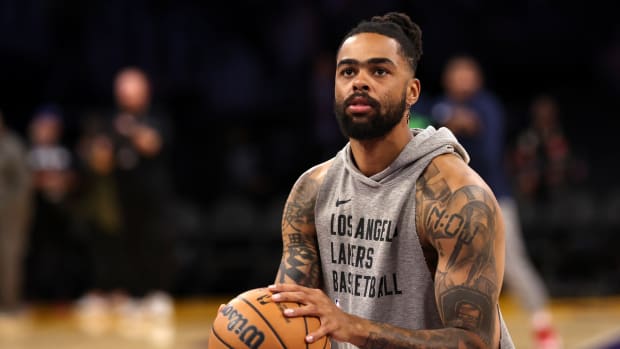Buyouts Are Warping the NBA's Competitive Landscape
Welcome to the Morning Shootaround, where every weekday you’ll get a fresh, topical column from one of SI.com’s NBA writers: Howard Beck on Mondays, Chris Mannix on Tuesdays, Michael Pina on Wednesdays, Chris Herring on Thursdays and Rohan Nadkarni on Fridays.
The NBA’s premier rebounder—a 6' 10" spring-loaded mass of muscle—will soon have a new team. And it won’t cost that team a thing.
To be clear: Andre Drummond will be paid many millions of dollars to haul in 10 to 15 boards a night, as he has for years. It’s just that Drummond’s new employer, the Lakers, won’t be paying most of it. Nor will they sacrifice anything to acquire Drummond’s elite skills for the stretch run.
Confused? Welcome to Buyout Season—a strange, unofficial space on the NBA calendar that was never intended to and probably shouldn’t exist, but just might swing the championship race.
Here’s how it works: Every season, teams try to unload unwanted veterans via trade, before the scheduled trade deadline. When those efforts fail, the team and the player arrange a buyout, in which the player agrees to a (usually minor) pay cut, the team pays out the remainder of his contract, then places him on waivers.
The bought-out player is then free to chase rings, shots or warmer weather—or sometimes, all of the above—usually by signing for the veteran’s minimum salary. His old team saves a few dollars, opens a roster spot and makes room for younger players to get reps. His new team gets a boost for the stretch run at relatively little expense. Everyone is happy!
Except, well, not everyone.
The Buyout Market, like much of the NBA ecosystem, mostly helps the bigger markets, the glamor teams and the contenders, further warping a competitive landscape that many teams believe is already stacked against them. “You’re just helping the rich get richer,” says a general manager with a small-market team.
And the market is booming in the wake of last week’s trade deadline. Former All-Star LaMarcus Aldridge, recently waived by the Spurs, promptly agreed to join the Nets. His decision came just three weeks after former All-Star Blake Griffin (bought out by the Pistons) chose Brooklyn, a big-market superteam built around Kevin Durant, James Harden and Kyrie Irving.
Drummond, the NBA’s leading rebounder over the last six years, reached a buyout deal with the Cavaliers last week. He chose one big-market contender (the Lakers) after seriously weighing an offer from another big-market contender (the Celtics).
The Lakers—in a tight race with the Clippers, Jazz, Nuggets and Suns for Western Conference supremacy—now get the benefit of a 27-year-old center who has averaged 17.5 points, 15.1 rebounds, 1.8 steals and 1.6 blocks over the last three seasons. The total cost to the Lakers? Less than $800,000 for the rest of this season, per ESPN’s Bobby Marks. This, for a player whose actual salary this season is $28.8 million.
Indeed, the rich are getting richer.
Bought-out players typically sign for a prorated portion of the minimum salary, allowing their new teams to add talent without regard for the salary cap.
“It’s a definite concern,” says another team executive working in a small market. “Without a doubt, players that are entering the buyout market will only be looking at contending teams. And most of the time, historically, their preference has been to go to the teams in the bigger markets. ... And it gives teams an opportunity to sit back and add players on minimum deals that they normally wouldn’t be able to acquire.”
It’s debatable whether Drummond was ever worth his lofty salary (which he earns thanks to the five-year, $127 million deal he signed with the Pistons in 2016). He’s made the All-Star team only twice in nine years, and some experts question whether rebounding is still a valuable commodity in today’s NBA.
Nevertheless, the Lakers just got a player recently valued at close to $30 million for relative pennies, despite being far over the cap and without having to trade a single player or draft pick. “The system is flawed,” says a third small-market GM. “You shouldn’t be adding to your team this deep in a season without giving things up.”
This isn’t merely the gripe of small-market teams, or even a matter of opinion; the Buyout Market directly (and objectively) undermines the NBA’s complex system of salary caps and luxury taxes. The whole point of all these rules is to limit how much elite talent a team can collect—and to force teams to make trade-offs and hard choices.
But the Buyout Market makes a mockery of it all. There is no sacrifice, at least for the glamor teams and the contenders. The Lakers, with LeBron James and Anthony Davis as high-priced franchise stars, would never be able to afford a $29 million rebounding specialist in a normal market (and will probably lose him to free agency this summer).
Aldridge (35) and Griffin (32) are both past their primes, but they are still solid players, and an incredible luxury for a Nets team already stocked with elite scorers. Aldridge’s contract with the Spurs paid $24 million this season (minus a reported $7.25 million buyout). Griffin’s contract was worth $36.8 million this season, and another $38.9 million next season (minus a reported $13.3 million buyout). The Nets just got them both for $2.1 million combined.
“This is creating a competitive advantage for the large, destination markets,” says the first team exec. “And it’s another inequity for the small markets.”
On a smaller scale, the Spurs signed Gorgui Dieng after he was released by the Grizzlies last week, a rare instance of a non-glamor team benefiting from this midseason free-agent bazaar. Still, free agency is supposed to happen in the offseason, when teams have planned for cap room, with a presumably equal chance to recruit talent.
Other contenders had to work a little harder to strengthen their rosters last week. The Nuggets traded players and draft picks to get Aaron Gordon. The Clippers had to give up Lou Williams, the three-time Sixth Man of the Year, to get Rajon Rondo. The Bucks traded players and picks to get P.J. Tucker. The Sixers traded players and picks to get George Hill. The Heat traded players and draft considerations to get Victor Oladipo.
But the Lakers effectively got Drummond for free, just as the Nets did with Griffin and Aldridge. And though all three could conceivably go elsewhere this summer, the Lakers and Nets now get several months to recruit them first.
And that also hurts their former teams, executives say. Rival teams pursuing those players never considered trading for them, because their large contracts made a trade unlikely. Everyone knew which players would be bought out, long before the trade deadline. So they just waited.
The Buyout Market is effectively a second free agency period, except it comes in the middle of the season, involves only a handful of franchises and doesn’t require cap room. And it was never intended to exist. There is no mention of a “buyout market” or a “midseason free agency period” in the NBA’s collective bargaining agreement. It has evolved on its own, over several years—driven primarily by star players and influential agents.
When a player grows discontented, he pushes for a trade. When no trade materializes, he pushes to get released or bought out. Teams feel pressure to agree, out of fear of alienating agents or being perceived as indifferent to a player’s wishes. Those things can haunt a team, especially a small-market one, when free agency rolls around.
“It’s very, very hard for the small markets or mid markets to say we’re not gonna buy you out,” said one small-market GM, “because you can’t get players there anyway. If you don’t do them favors, an agent will say, ‘I’m not gonna bring my guys to you.’”
But midseason buyouts used to be much rarer. The phrase buyout market was rarely used around the NBA until about 2016, according to a Nexis search, but it spiked two years later and has become a permanent part of the lexicon.
Some team executives have pushed for reform, to no avail. One suggestion is to make buyout players ineligible for the playoffs unless they have been released at some date before the trade deadline—say, in early February—thus incentivizing teams to trade for the players. Another option would be to create a compensation system, in which the team signing the player has to send a draft pick (or possibly multiple picks, depending on the player) to the player’s former team. A third proposal would be to give each team a cap exception specifically for buyout signings—and limit it to one per season, or even one every two years. A fourth option would be to have teams place a blind bid for bought-out players, using whatever cap room or cap exceptions they have available, with the player awarded to the highest bidder.
The small-market execs hope the issue gets addressed in the next CBA, which would begin in 2024, after the current deal expires. But they are not particularly optimistic. As they see it, NBA officials are driven by marketing and money, and having marquee names congregate in glamor markets, or on title contenders, is good for ratings.
“The way you know the NBA doesn’t think it’s a problem is they’re reticent to acknowledge it’s been a problem,” says one of the small-market execs. “The inaction tells you, ‘We’re cool with it.’ ”
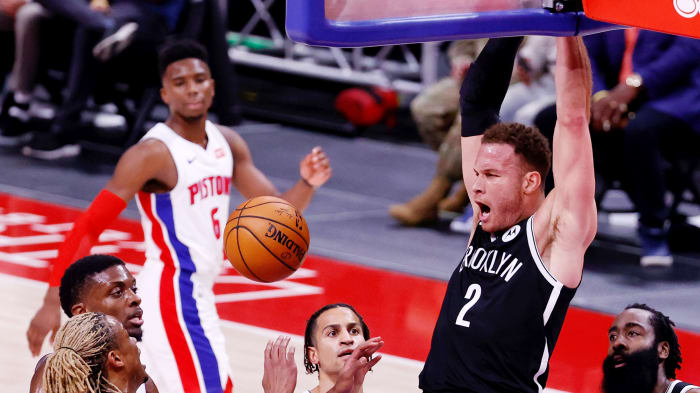
The Pistons bought out Griffin then honored him with a video tribute; he responded by dunking on them in a 113–111 win Friday.
Rick Osentosk/iUSA TODAY Sports
LUKEWARM TAKE OF THE WEEK
The Pistons played a video tribute for Blake Griffin on Friday—his first game in Detroit since his buyout. It was a nice gesture. But we need a new standard for these things.
Griffin played 138 regular-season games for the Pistons, not even two full seasons. He led them to one playoff appearance—a four-game, first-round sweep by the Bucks. He did make one All-Star team as a Piston, in 2019. But his tenure was otherwise an expensive, regrettable and mostly unmemorable chapter, marred by injuries and general decline. So what, exactly, were the Pistons paying tribute to?
I’m not sure when the tribute video became standard operating procedure for NBA teams, but it’s reached the point of absurdity. The Hawks produced one in 2018 for Dwight Howard—Dwight Howard!—whom they’d traded (as quickly as possible) after just one season.
Can we save the tributes for the truly memorable players? The ones who left an impression? The perennial All-Star? The five-year starter? The plucky fan favorite? Or at least for the guy who hit that one big shot in the playoffs?
Teams are certainly in a difficult spot here. The more these videos proliferate, the more pressure there is to do them for everyone, lest you look like the one team that isn’t properly appreciative of its former players. You never want to leave a bad impression on an influential player (or his agent). In the free-agent bidding wars, every edge matters.
Listen, appreciation is good. I am stridently pro-appreciation. I appreciate that teams are appreciative of their former players. But these videos now feel like AYSO participation trophies—if everyone gets them, they cease to mean anything.
More Morning Shootaround
Nadkarni: The Nuggets have stumbled into their lineup of the future
Herring: Inside the NBA's year of the lefty
Pina: Dončić is finding his rhythm behind the three-point line






























